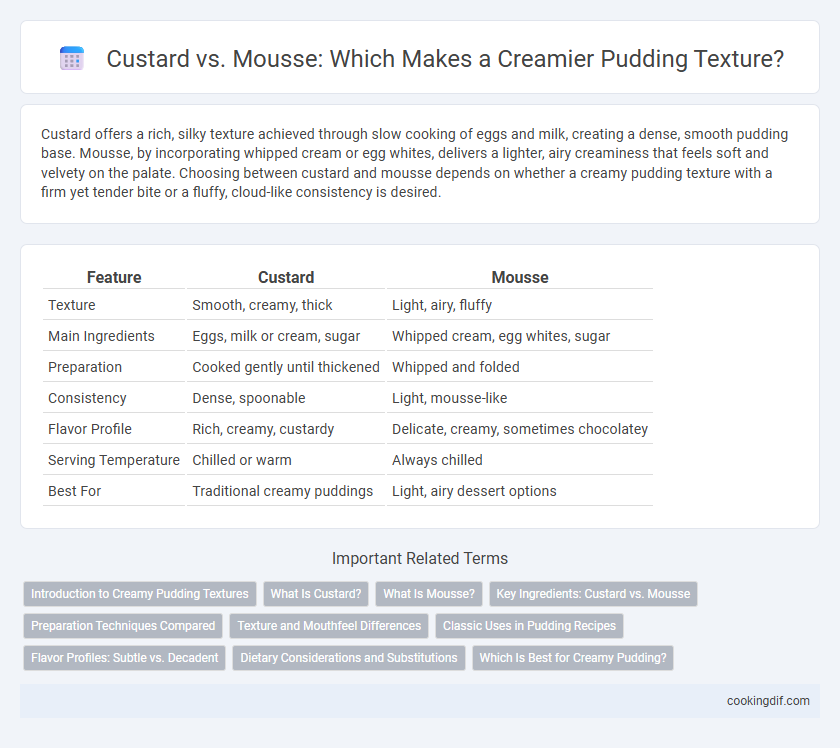Custard offers a rich, silky texture achieved through slow cooking of eggs and milk, creating a dense, smooth pudding base. Mousse, by incorporating whipped cream or egg whites, delivers a lighter, airy creaminess that feels soft and velvety on the palate. Choosing between custard and mousse depends on whether a creamy pudding texture with a firm yet tender bite or a fluffy, cloud-like consistency is desired.
Table of Comparison
| Feature | Custard | Mousse |
|---|---|---|
| Texture | Smooth, creamy, thick | Light, airy, fluffy |
| Main Ingredients | Eggs, milk or cream, sugar | Whipped cream, egg whites, sugar |
| Preparation | Cooked gently until thickened | Whipped and folded |
| Consistency | Dense, spoonable | Light, mousse-like |
| Flavor Profile | Rich, creamy, custardy | Delicate, creamy, sometimes chocolatey |
| Serving Temperature | Chilled or warm | Always chilled |
| Best For | Traditional creamy puddings | Light, airy dessert options |
Introduction to Creamy Pudding Textures
Custard delivers a smooth, velvety texture achieved through slow cooking eggs and milk until thickened, creating a rich and silky base ideal for creamy puddings. Mousse incorporates whipped cream or egg whites, providing a light, airy texture while maintaining creaminess, offering a contrast to the denser custard. Understanding the differences in preparation and texture between custard and mousse is essential for crafting the perfect creamy pudding experience.
What Is Custard?
Custard is a rich, creamy pudding made from a blend of milk or cream, egg yolks, and sugar, gently cooked until it thickens into a smooth, velvety texture. Its thickness comes from the coagulation of egg proteins, which creates a dense and silky consistency distinctly different from mousse, which relies on whipped cream or egg whites for a light, airy texture. The precise cooking temperature and method are crucial to achieving custard's signature creamy texture without curdling or over-thickening.
What Is Mousse?
Mousse is a light, airy dessert made by folding whipped cream or beaten egg whites into a flavored base, resulting in a fluffy and delicate texture. Unlike custard, which relies on thickening agents like eggs and cream to achieve a smooth, dense consistency, mousse emphasizes volume and lightness. This difference in preparation creates mousse's signature creamy yet airy pudding texture that melts effortlessly on the palate.
Key Ingredients: Custard vs. Mousse
Custard achieves its creamy pudding texture primarily through the thickening power of egg yolks combined with milk or cream, which provides a smooth, rich consistency. Mousse relies on whipped egg whites or heavy cream folded into a base, creating a lighter, airy texture with a delicate creaminess. The key difference lies in custard's denser blend of dairy and eggs versus mousse's incorporation of aeration for a fluffier mouthfeel.
Preparation Techniques Compared
Custard achieves its creamy pudding texture through slow cooking with gentle heat, allowing egg proteins to thicken the milk mixture into a smooth, velvety consistency. Mousse, on the other hand, relies on whipping air into ingredients like whipped cream or egg whites, creating a light, airy texture with a creaminess that feels lighter than custard. The preparation of custard demands precise temperature control to avoid curdling, while mousse requires careful folding techniques to maintain its delicate structure and fluffy texture.
Texture and Mouthfeel Differences
Custard features a smooth, velvety texture achieved through slow cooking and the coagulation of egg proteins, resulting in a rich, dense mouthfeel. Mousse offers a lighter, airy consistency due to the incorporation of whipped cream or egg whites, creating a creamy but fluffy texture. These distinct preparation methods define the contrast in creaminess and mouthfeel between custard and mousse in pudding desserts.
Classic Uses in Pudding Recipes
Custard and mousse both provide creamy pudding textures but differ significantly in structure and preparation. Classic custard uses egg yolks and milk or cream gently cooked to create a smooth, thick base ideal for traditional puddings like creme brulee and flan. Mousse incorporates whipped cream or egg whites, resulting in a lighter, airier texture commonly found in chocolate or fruit pudding recipes.
Flavor Profiles: Subtle vs. Decadent
Custard offers a subtly rich flavor with smooth, creamy notes that highlight natural vanilla or egg undertones, creating an elegant, comforting pudding experience. Mousse provides a more decadent and intense taste profile, often incorporating whipped cream or chocolate to deliver a light yet indulgently airy texture. Choosing between custard and mousse depends on whether a delicate or bold flavor is preferred in a creamy pudding.
Dietary Considerations and Substitutions
Custard offers a rich, creamy pudding texture primarily made with eggs and dairy, which may pose challenges for those with lactose intolerance or egg allergies. Mousse provides a lighter, airy texture often achieved using whipped cream or egg whites, and can be adapted with dairy-free alternatives like coconut cream or aquafaba for vegan and allergy-friendly diets. Choosing between custard and mousse depends on dietary restrictions, with mousse showing greater flexibility for substitutions to accommodate vegan, gluten-free, or low-fat preferences.
Which Is Best for Creamy Pudding?
Custard delivers a rich, velvety texture achieved through slow cooking eggs and milk, creating a thick, creamy pudding base perfect for a smooth mouthfeel. Mousse, made by folding whipped cream or egg whites into a flavored base, results in a lighter, airy texture that offers a delicate creaminess but less density than custard. For an intensely creamy pudding with a luxurious body, custard is best, whereas mousse suits those preferring a fluffy, less heavy dessert experience.
custard vs mousse for creamy pudding texture Infographic

 cookingdif.com
cookingdif.com